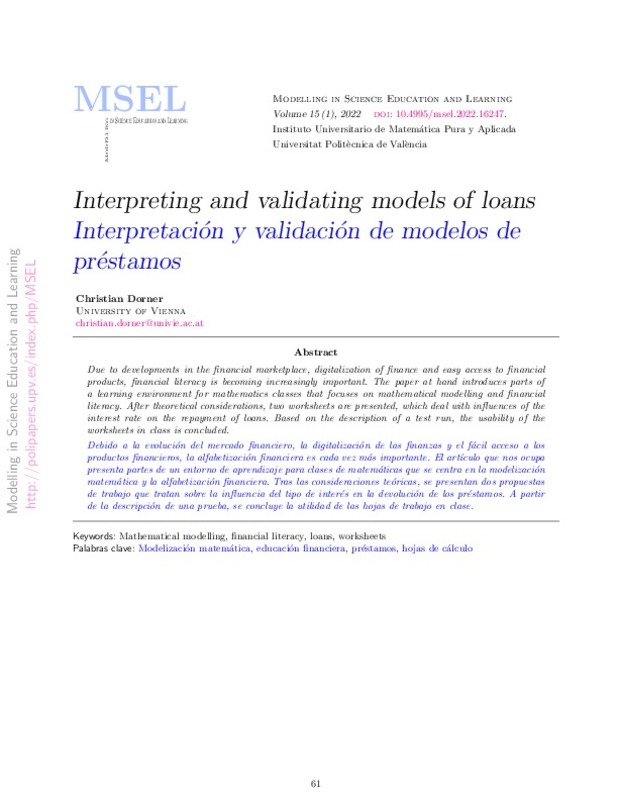Blum, W., & Leiß, D. (2007). How do students and teachers deal with modelling problems? In C. Haines, P. Galbraith, W. Blum, & S. Khan (Eds.), Mathematical Modelling (ICTMA 12): Education, Engineering and Economics (pp. 222-231). Horwood Publishing Limited. https://doi.org/10.1533/9780857099419.5.221
Blum, W. (2011). Can modelling be taught and learnt? Some answers from empirical research. In G. Kaiser, W. Blum, R. Borromeo Ferri, & G. Stillman (Eds.), Trends in Teaching and Learning of Mathematical Modelling (pp. 15-30). Springer. https://doi.org/10.1007/978-94-007-0910-2_3
Borromeo Ferri, R. (2011). Wege zur Innenwelt des mathematischen Modellierens. Kognitive Analysen zu Modellierungsprozessen im Mathematikunterricht [Paths to the inner world of mathematical modelling. Cognitive analysis of modelling processes in math classes]. Vieweg+Teubner. https://doi.org/10.1007/978-3-8348-9784-8
[+]
Blum, W., & Leiß, D. (2007). How do students and teachers deal with modelling problems? In C. Haines, P. Galbraith, W. Blum, & S. Khan (Eds.), Mathematical Modelling (ICTMA 12): Education, Engineering and Economics (pp. 222-231). Horwood Publishing Limited. https://doi.org/10.1533/9780857099419.5.221
Blum, W. (2011). Can modelling be taught and learnt? Some answers from empirical research. In G. Kaiser, W. Blum, R. Borromeo Ferri, & G. Stillman (Eds.), Trends in Teaching and Learning of Mathematical Modelling (pp. 15-30). Springer. https://doi.org/10.1007/978-94-007-0910-2_3
Borromeo Ferri, R. (2011). Wege zur Innenwelt des mathematischen Modellierens. Kognitive Analysen zu Modellierungsprozessen im Mathematikunterricht [Paths to the inner world of mathematical modelling. Cognitive analysis of modelling processes in math classes]. Vieweg+Teubner. https://doi.org/10.1007/978-3-8348-9784-8
Dorner, C. (2017). Schulrelevante Aspekte der Finanzmathematik [School-relevant aspects of financial mathematics]. Ph.D.-thesis. University of Vienna.
EOS (2017). Presseinformation: EOS Schulden Studie 2017. Das Leben auf Pump wird immer unbeliebter [Press release: EOS debt study 2017. Life on credit is becoming increasingly unpopular.]. https://de.eos-solutions.com/press/pressreleases/PRs-Group-Kopie/20170101.html
Greefrath, G., & Vorhölter, K. (2016). Teaching and Learning Mathematical Modelling - Approaches and Developments from German Speaking Countries. Springer. https://doi.org/10.1007/978-3-319-45004-9
Greefrath, G., Hertleif, C., & Siller, H.-S. (2018). Mathematical modelling with digital tools - a quantitative study on mathematising with dynamic geometry software. ZDM Mathematics Education, 50(1-2), 233-244. https://doi.org/10.1007/s11858-018-0924-6
Fischer, R. (2001.). Höhere Allgemeinbildung [General higher education]. In A. Fischer, A. Fischer-Buck, K. H. Schäfer, D. Zöllner, R. Aulcke, & F. Fischer (Eds.), Situation und Ursprung von Bildung, Franz-Fischer-Jahrbuch [Situation and origin of education, Franz Fischer yearbook] (S. 151-161). Universitätsverlag Leipzig.
Hankeln, C., & Greefrath, G. (2020). Mathematische Modellierungskompetenz fördern durch Lösungsplan oder Dynamische Geometrie-Software? Empirische Ergebnisse aus dem LIMo-Projekt [Promote mathematical modelling skills through a solution plan or dynamic geometry software? Empirical results from the LIMo project.]. Journal für Mathematik-Didaktik. Published online. https://doi.org/10.1007/s13138-020-00178-9
ING-DiBa (2016). Pressemitteilung: Jeder Zweite hat Konsumschulden. Fast jeder zweite Österreicher (genau 47%) hat Konsumschulden - was nicht wirklich zum persönlichen Wohlbefinden beiträgt [Press release: Every second Austrian has consumer debt. Almost every second Austrian (exactly 47%) has consumer debt - which does not really contribute to personal wellbeing.]. https://www.ing.at/fileadmin/uploads/media/kommunikation/pressemeldungen/2016/PI_29_06_2016_Privatschulden/PI_Privatschulden_29062016_V02.pdf
Lusardi, A., & Mitchell, O. (2014). The economic importance of financial literacy: Theory and evidence. Journal of Economic Literature, 52(1), 5-44. https://doi.org/10.1257/jel.52.1.5
Maaß, K. (2004). Mathematisches Modellieren im Unterricht: Ergebnisse einer empirischen Studie [Mathematical modelling in the classroom: results of an empirical study]. Franzbecker. https://doi.org/10.1007/BF03339002
Maaß, K. (2006). What are modelling competencies? ZDM, 38(2), 113-142. https://doi.org/10.1007/BF02655885
Mills, J. D. (2002). Using computer simulation methods to teach statistics: A review of the literature. Journal of Statistics Education, 10(1), 20 pages. https://doi.org/10.1080/10691898.2002.11910548
Moreno-Armella, L., Hegedus, S., & Kaput, J. (2008). From static to dynamic mathematics: Historical and representational perspectives. Educational Studies in Mathematics, 68(2), 99-111. https://doi.org/10.1007/s10649-008-9116-6
Mousoulides, N. G. (2011). Geogebra as a conceptual tool for modeling real world problems. In L. Bu & R. Schoen (Eds.), Model-centered Learning - Pathways to Mathematical Understanding Using GeoGebra (pp. 105-118). SensePublishers. https://doi.org/10.1007/978-94-6091-618-2_8
OECD (2016). OECD/INFE International Survey of Adult Financial Literacy Competencies. PISA, OECD Publishing. Published online.
OECD (2019a). PISA 2018 Assessment and Analytical Framework, PISA, OECD Publishing. https://doi.org/10.1787/b25efab8-en
OECD (2019b). PISA 2021 Financial Literacy Analytical and Assessment Framework. PISA, OECD Publishing. Published online.
OECD (2020). PISA 2018 Results (Volume IV): Are Students Smart about Money? PISA, OECD Publishing. https://doi.org/10.1787/48ebd1ba-en
Ozkale, A., & Erdogan, O. E. (2020). An analysis of the interaction between mathematical literacy and financial literacy in PISA*. International Journal of Mathematical Education in Science and Technology. Published online. https://doi.org/10.1080/0020739X.2020.1842526
Pead, D., Bill, R., & Muller, E. (2007). Uses of technologies in learning mathematics through modelling. In W. Blum, P. Galbraith, H.-W. Henn, & M. Niss (Eds.), Modelling and Applications in Mathematics Education. The 14th ICMI study (pp. 309-318). Springer. https://doi.org/10.1007/978-0-387-29822-1_32
Pollak, H. O. (1977). The interaction between mathematics and other school subjects (including integrated courses). In H. Athen & H. Kunle (Eds.), Proceedings of the Third International Congress on Mathematical Education. Zentralblatt für Didaktik der Mathematik [The International Journal on Mathematics Education] (pp. 255-264).
Siller, H.-S., & Greefrath, G. (2010). Mathematical modelling in class regarding to technology. In V. Durand-Guerrier, S. Soury-Lavergne, & F. Arzarello (Eds.), Proceedings of the sixth Congress of the European Society for Research in Mathematics Education (pp. 2136-2145). Institut National de Recherche Pédagogique. http://ife.ens-lyon.fr/publications/edition-electronique/cerme6/wg11-10-siller.pdf
Schupp, H. (1989). Applied mathematics instruction in the lower secondary level - Between traditional and new approaches. In W. Blum, J. S. Berry, R. Biehler, I. D. Huntley, G. Kaiser-Messmer, & L. Profke (Eds.), Applications and Modelling in Learning and Teaching Mathematics (pp. 37-46). Ellis Horwood.
Sole, M. A. (2014). Financial literacy: An essential component of mathematics literacy and numeracy. Journal of Mathematics Education at Teachers College, 5(2), 55-62. https://doi.org/10.7916/jmetc.v5i2.655
Sole, M. A. (2017). Financial education: Increase your purchasing power. Mathematics Teacher, 111(1), 60-64. https://doi.org/10.5951/mathteacher.111.1.0060
Wess, R. (2020). Professionelle Kompetenz zum Lehren mathematischen Modellierens. Konzeptualisierungen, Operationalisierungen und Förderung von Aufgaben- und Diagnosekompetenz [Professional competence in teaching mathematical modelling. Conceptualizations, operationalizations and promotion of task and diagnostic skills]. Springer Spektrum. https://doi.org/10.1007/978-3-658-29801-2
[-]








